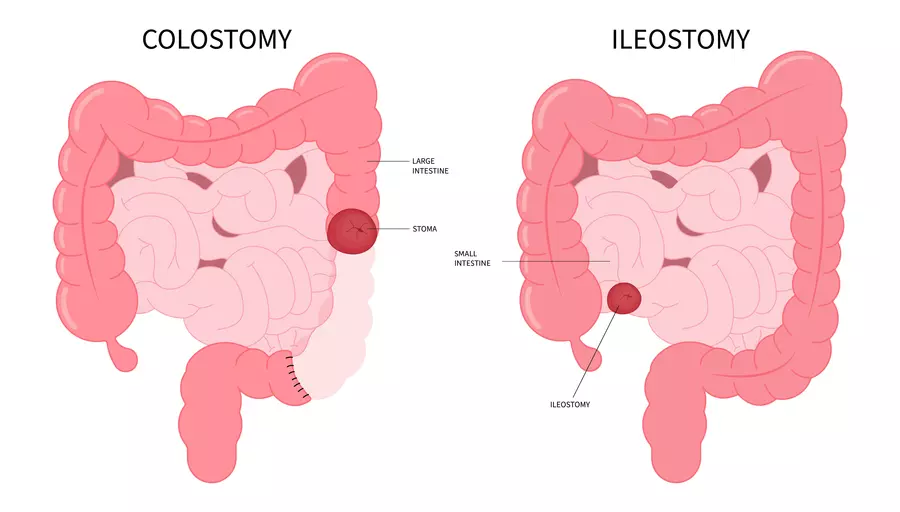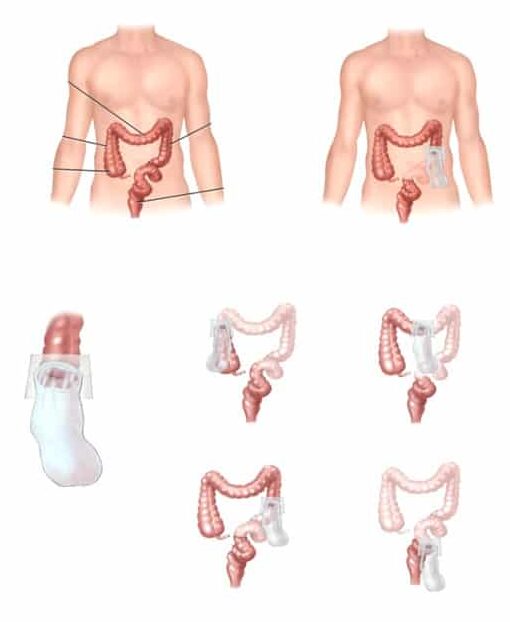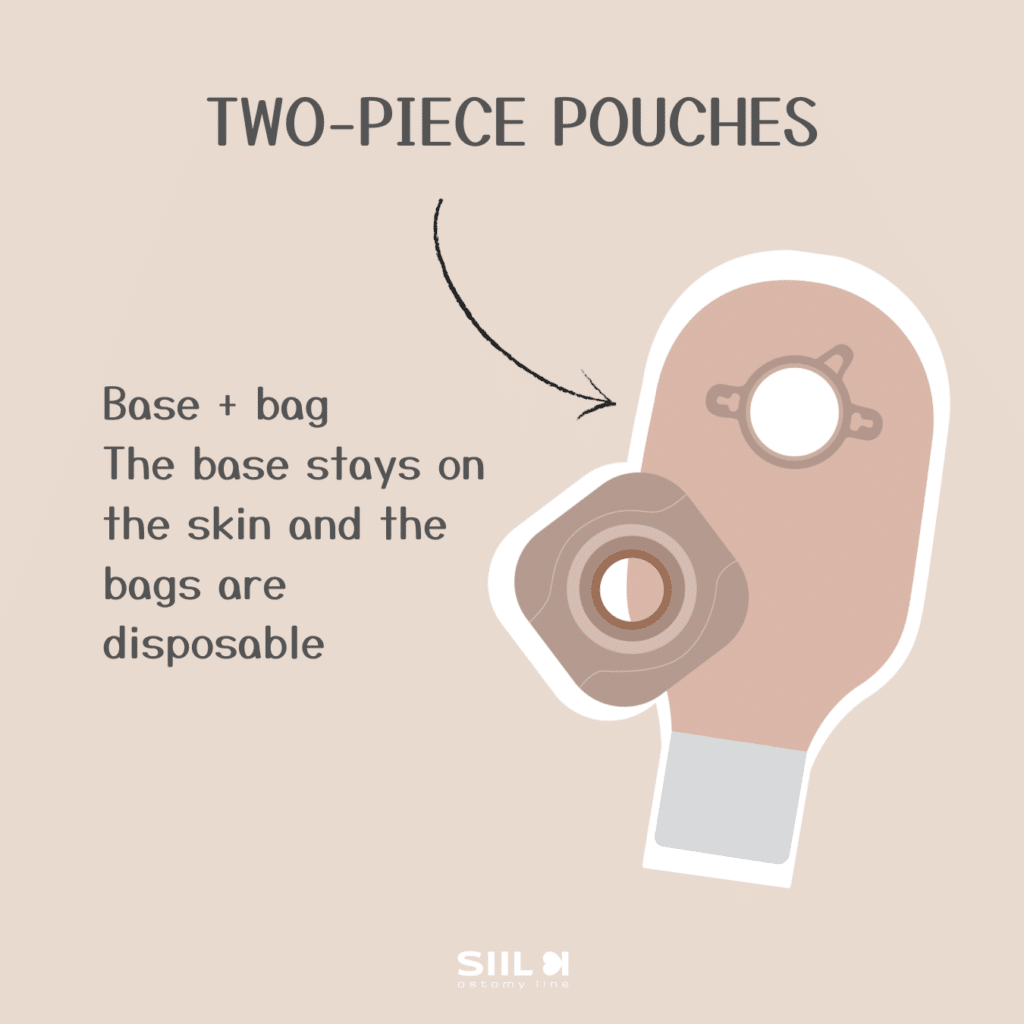
FREE DELIVERY IN USA OVER $120
FREE DELIVERY IN EUROPE OVER $100
Ileostomy vs Colostomy is a common question, let’s find out:
When comparing an ileostomy and a colostomy, it’s important to understand the key differences between these two types of ostomies, as they relate to different parts of the intestines and serve different purposes.
An ileostomy is created by bringing a part of the ileum (the last segment of the small intestine) to the surface of the abdomen to form a stoma. This is usually done when the entire colon, or a large portion of it, needs to be bypassed or removed. With an ileostomy, the output is typically more liquid because it bypasses the colon, where water is usually absorbed. This can mean more frequent emptying of the ostomy bag and a greater focus on hydration and electrolyte balance.
A colostomy, on the other hand, involves bringing part of the colon (the large intestine) to the surface of the abdomen. This is performed when a portion of the colon is removed or bypassed. The output from a colostomy is generally more solid and less frequent than with an ileostomy, as the colon partly continues its role in absorbing water and forming stool.
Life with an ileostomy or colostomy involves learning how to care for the stoma and manage the ostomy appliance. Both require attention to skin care around the stoma, understanding how to change the appliance, and adapting to lifestyle changes. Dietary considerations may differ, as those with an ileostomy might need to be more cautious about foods that could cause blockages in the smaller intestine.
Emotionally, both ileostomy and colostomy patients may experience challenges such as adjusting to the presence of the ostomy bag, concerns about body image, and the impact on social and intimate relationships. However, with education, support, and time, individuals with either an ileostomy or colostomy can lead active, fulfilling lives.
Colostomy vs Ileostomy is a common question, let’s find out:
In the context of ostomy surgeries, understanding the differences between a colostomy and an ileostomy is crucial for patients and caregivers alike. A colostomy involves creating an opening in the colon, or large intestine, to allow waste to exit the body.
This procedure is often necessary when a portion of the colon is either damaged or needs to be bypassed due to diseases such as colon cancer, diverticulitis, or blockages. The stoma, or opening, created in a colostomy is typically located on the left side of the abdomen.
On the other hand, an ileostomy is a surgical procedure that creates an opening in the ileum, the last section of the small intestine. It’s usually required when the entire colon has to be bypassed, as in the cases of ulcerative colitis or Crohn’s disease. The stoma for an ileostomy is generally situated on the right side of the abdomen.
The type of waste expelled through a colostomy is typically more solid, as it comes from the large intestine, which is responsible for water absorption and stool formation. In contrast, waste from an ileostomy is usually more liquid, as it’s ejected from the small intestine, where the stool has not yet had water absorbed from it.
Post-operative care and lifestyle adjustments are also different for each procedure. For instance, ileostomy patients may need to be more vigilant about hydration and electrolyte balance due to the more liquid nature of their waste.
Both colostomy and ileostomy patients, however, require education on managing their stoma, recognizing signs of complications, and adapting their diet and lifestyle to their new situation.
In summary, while both colostomies and ileostomies are life-altering procedures, each has distinct aspects in terms of surgical process, post-operative care, and the impact on the patient’s lifestyle.
Understanding these differences is essential for those undergoing these surgeries and for healthcare professionals providing pre- and post-operative care.
ILeostomy VS Colostomy :
Everything you need to know
An ostomy is a surgical procedure that involves creating an opening in the abdomen to allow for the elimination of waste from the body.
Depending on the type of surgery, an individual may require an ileostomy or colostomy bag to manage waste.

1.
What is an Ileostomy ?
An ileostomy is a surgical procedure that creates an opening in the abdomen to divert the normal flow of the small intestine, specifically the ileum, to an external pouch.
This procedure is often necessary for patients who have severe inflammatory bowel diseases like Crohn’s disease or ulcerative colitis, or in cases where a part of the bowel has been damaged or removed due to cancer or other conditions.
The output from an ileostomy is typically more liquid than that from a colostomy because it bypasses the large intestine, where most of the water absorption occurs.
As a result, ileostomy patients need to be particularly mindful of hydration and electrolyte balance. Adapting to life with an ileostomy involves learning to manage the stoma (the external opening) and the ileostomy bag, understanding how to prevent skin irritation, and making dietary adjustments to avoid blockages and ensure proper nutrition.
Living with an ileostomy also requires emotional and psychological adjustments. Support from healthcare professionals, support groups, and counseling can be invaluable in adapting to the changes in body image and lifestyle.
It’s important for ileostomy patients to know that with proper care and management, they can lead active, fulfilling lives.
An ileostomy bag is a critical component for individuals who have undergone an ileostomy procedure. This bag, which is attached to the stoma created during the surgery, collects waste that is diverted from the small intestine. The design of an ileostomy bag is such that it adheres securely to the skin around the stoma, ensuring that waste is collected without leakage or skin irritation.
One of the key considerations for those using an ileostomy bag is ensuring proper hygiene and care. This involves regular changing of the bag, cleaning the skin around the stoma, and monitoring for any signs of irritation or infection. It’s important to choose the right type of ileostomy bag based on individual needs and lifestyle – for instance, different capacities, wear times, and features like filters for odor control.
In terms of living with an ileostomy bag, individuals need to be mindful of their diet, as certain foods can affect the output consistency and volume. Staying hydrated is also crucial, as the ileostomy bypasses the large intestine where most water absorption occurs.
Emotionally, adjusting to life with an ileostomy bag can be challenging. People might feel self-conscious about the bag or worry about how it may impact their daily activities. However, with the right support and education, most individuals are able to resume their normal activities, including sports, travel, and work.
In summary, while an ileostomy bag necessitates certain adjustments, with appropriate care and management, individuals can lead a healthy and active life. It’s about finding the right balance and making necessary adaptations to ensure both comfort and functionality.
An ileostomy is a type of ostomy procedure where the small intestine is redirected to create a stoma for the elimination of waste products.
The waste products are typically looser in consistency, meaning that the individual may need to change their ileostomy bag more frequently than a colostomy bag.
2.
What is a Colostomy ?
A colostomy is a surgical procedure where a portion of the colon (large intestine) is brought to the surface of the abdomen to create a stoma, or opening. This procedure is typically required when a part of the colon cannot perform its function due to disease, injury, or other medical conditions. The main purpose of a colostomy is to allow for the removal of waste from the body when the lower part of the colon or rectum is not functioning properly.
There are different types of colostomies, depending on which part of the colon is diverted. The consistency of the output from the stoma varies based on the location of the colostomy. A colostomy higher up in the colon will produce more liquid output, while one lower down will have more formed stools, as more water is absorbed back into the body.
After a colostomy procedure, patients need to learn how to care for their stoma and manage their colostomy bag. This involves regular cleaning, monitoring the stoma for any changes or complications, and changing the colostomy bag as needed. The type of bag used can vary based on personal preference and lifestyle needs, and accessories such as a housse pour stomie can provide additional comfort and discretion.
Dietary changes might also be necessary after a colostomy. Some foods can cause gas, odors, or affect the consistency of the stool, and patients often go through a period of dietary adjustment to understand how their body reacts to different foods.
Emotionally, adjusting to life after a colostomy can be challenging. Patients may have concerns about body image, lifestyle changes, and how the colostomy will affect their daily activities and relationships. However, with support from healthcare professionals, support groups, and other resources, many individuals adapt well and lead full, active lives.
In summary, a colostomy is a life-altering surgery, but with proper care and adjustment, patients can continue to enjoy a quality of life and engage in most activities they participated in before the surgery.
A colostomy is a type of ostomy procedure where a portion of the large intestine is redirected to create a stoma for the elimination of waste products.
The waste products produced through a colostomy stoma are generally formed and firm, and individuals catch the output in a colostomy bag.
There are four types of colostomies – ascending, transverse, descending, and sigmoid.
3.
The primary difference between an ileostomy and a colostomy lies in the location and part of the digestive tract involved.
An ileostomy involves the ileum, the last part of the small intestine.
In contrast, a colostomy involves the colon, also known as the large intestine.
A colostomy bag is an essential component for individuals who have undergone a colostomy procedure. This bag is attached to the stoma, an opening created on the abdomen during the surgery, to collect waste from the colon. The colostomy bag is designed to adhere securely to the skin around the stoma, ensuring that waste is collected efficiently, without any leakage, and minimizing skin irritation.
Proper management of a colostomy bag is crucial for maintaining hygiene and comfort. This includes regular changing of the bag, cleaning the skin around the stoma, and ensuring the bag fits well to prevent leaks and skin irritation. The frequency of changing the colostomy bag depends on the type of colostomy, individual lifestyle, and the nature of the output.
Individuals with a colostomy bag often need to be attentive to their diet, as certain foods can affect the odor and consistency of the waste. While most people can return to a normal diet post-surgery, they may need to make adjustments based on how their body reacts to different foods.
Emotionally, adapting to life with a colostomy bag can be challenging. Concerns about the bag being visible, worries about odor or leakage, and adjusting to this new bodily change are common. However, many find that with time, support, and education, they can confidently manage their colostomy and continue to engage in activities they enjoy.
In essence, while living with a colostomy bag requires adjustments and learning, it doesn’t have to significantly limit an individual’s lifestyle. With proper care and management, individuals with a colostomy can lead an active, fulfilling life.

The location of ileostomy vs colostomy differs depending on which part of the gastrointestinal tract is diverted.
An ileostomy is typically located on the right side of the abdomen, while a colostomy’s location can vary, usually on the left side, but it depends on which part of the colon is diverted.

The placement of the stoma can impact the type of ostomy bag used and the care required.
Both procedures require a pouching system to collect waste, but the ileostomy vs colostomy bag choice may vary based on personal preference, lifestyle, and the stoma’s output.
4.
Ileostomy vs Colostomy Output
The appearance of an ileostomy and a colostomy can be noticeably different, primarily due to the location of the stoma and the nature of the intestinal tissue involved.
An ileostomy is created from a part of the ileum, the last segment of the small intestine. The stoma, which is where the intestine is brought to the surface of the abdomen, often appears smaller and may protrude more. The output is liquid to pasty in consistency and is continuous, as the small intestine constantly processes food.
In contrast, a colostomy involves bringing a part of the colon, or large intestine, to the surface of the abdomen. The stoma for a colostomy is generally larger and less protruding than that of an ileostomy. The output from a colostomy is more formed and less frequent, as it comes from the large intestine, where water is absorbed from the waste, making it more solid.
Both types of stomas are typically round and moist, resembling the inside of the mouth. The color is usually pink to red, indicating healthy blood supply. The differences between an ileostomy vs colostomy appearance are influenced by the different functions and structures of the small and large intestines, which is important for patients to understand for proper stoma care and management.
Another crucial distinction lies in the output and stool consistency, which results from the ileostomy vs colostomy difference.
With an ileostomy, the waste material is typically liquid to semi-liquid because it bypasses the colon, where water is usually absorbed. This output is consistent and occurs throughout the day.
On the other hand, a colostomy results in a more solid stool consistency, similar to a regular bowel movement, because the colon partially or completely remains involved in the digestive process.
This output can sometimes be regulated with diet and irrigation techniques.
When discussing “ileostomy vs colostomy stool consistency,” it’s important to note the distinct differences due to the location of the stoma in the digestive tract. In an ileostomy, where the stoma is connected to the ileum, or the end part of the small intestine, the stool consistency is generally liquid to pasty. This is because the waste bypasses the large intestine, where most of the water absorption occurs. As a result, ileostomy output is more frequent and less formed, requiring patients to empty their ostomy bags multiple times a day.
In contrast, with a colostomy, the stoma is connected to the colon, or large intestine. Here, the “ileostomy vs colostomy stool consistency” difference is quite evident. The colostomy allows for more water to be absorbed from the waste, leading to a stool consistency that is more formed and solid, similar to a regular bowel movement. The frequency of output is also less compared to an ileostomy, often allowing patients to manage their condition with closed ostomy bags and regular, controlled emptying.
Understanding the “ileostomy vs colostomy stool consistency” is vital for individuals with these conditions, as it influences the management, care, and lifestyle adjustments needed for each type of ostomy.
Given the differences in output and stool consistency, the care for an ileostomy and colostomy stoma can vary.
Ileostomy care requires regular monitoring due to the more frequent and less predictable output.
In contrast, colostomy care can often follow a more predictable pattern due to the more solid and regular stool.
Understanding the key differences between an ileostomy and a colostomy is crucial for anyone considering or undergoing these surgeries. The primary distinction lies in the location of the surgical opening. An ileostomy involves creating an opening in the ileum, the final segment of the small intestine. This is usually done when the entire colon, or a large portion of it, needs to be bypassed or removed. The output from an ileostomy is typically more fluid because it is from the small intestine.
On the other hand, a colostomy involves an opening in the colon (large intestine). This procedure is necessary when only part of the colon is affected or needs to be bypassed. The output from a colostomy is generally more solid, as it comes from the large intestine, which is responsible for solidifying waste.
Both procedures lead to the creation of a stoma, but the nature of the waste output and the specific care requirements for each type of stoma can vary significantly. These ileostomy vs colostomy difference /s can have implications for the patient’s lifestyle, diet, and overall management of the stoma. Understanding these distinctions is important for effective post-operative care and adapting to life with a stoma.
5.
When comparing an “ileostomy bag vs colostomy bag,” it’s important to understand how the differences in the output of an ileostomy and a colostomy influence the type of bag used.
An ileostomy bag is designed to collect the more liquid and continuous output typical of an ileostomy. Since the waste comes from the small intestine, it’s more fluid-like, requiring the ileostomy bag to be emptied more frequently. These bags are generally smaller and need to be drainable to manage the frequent liquid output.
In contrast, a colostomy bag is used for collecting waste from a colostomy, which involves the large intestine. The output here is more solid and less frequent, resembling normal stool. Therefore, colostomy bags can be larger and are often closed-ended, meaning they are replaced rather than emptied. Some people with colostomies may also use a stoma cap or mini-pouch during certain times when they expect less output.
The “ileostomy bag vs colostomy bag” distinction is crucial for patients to understand for effective ostomy management. Each type of bag is specifically designed to accommodate the different types of waste output and frequency of disposal, ensuring comfort and convenience for the user.

There are various types of ostomy bags available to suit the needs of different individuals. These include one-piece and two-piece systems, as well as closed and drainable bags. One-piece systems have the skin barrier and pouch attached, while two-piece systems have a separate skin barrier and pouch that can be detached. Closed bags are typically used for more solid waste, while drainable bags are used for liquid or semi-liquid waste.
A colostomy bag is a pouch that is attached to the stoma to collect waste from the colon. The bag is made of a durable, odor-proof material and has a skin barrier that adheres to the skin around the stoma. The bag can be emptied and cleaned as needed, and there are various sizes and styles available to suit the needs of different individuals.
An ileostomy bag is a pouch that is attached to the stoma to collect waste from the small intestine. The bag is made of a durable, odor-proof material and has a skin barrier that adheres to the skin around the stoma. The bag can be emptied and cleaned as needed, and there are various sizes and styles available to suit the needs of different individuals.
When discussing “colostomy bag vs ileostomy,” it’s essential to understand both the differences in the surgical procedures themselves and the types of ostomy bags they require. A colostomy involves creating an opening in the colon (large intestine), leading to a stoma through which waste exits the body. The output from a colostomy is more solid and less frequent, similar to regular bowel movements. Consequently, colostomy bags are often closed-ended, meaning they are disposable and replaced once full. Some patients may even use a stoma cap or mini-pouch, especially if they have a predictable bowel routine.
On the other hand, an ileostomy involves creating a stoma from the ileum, the last part of the small intestine. The output is more liquid and continuous since it bypasses the large intestine where water absorption occurs. Therefore, ileostomy bags are designed to be drainable to manage the frequent liquid output. These bags are usually smaller and need to be emptied multiple times a day.
In the “colostomy bag vs ileostomy” comparison, it’s clear that the differences in the surgical procedures and the part of the intestine involved directly influence the type of ostomy bag used. This distinction is vital for patients for effective management and care of their ostomy, ensuring they choose the right type of bag for their specific needs.
When it comes to managing waste after an ostomy procedure, there are several options to choose from.
These include one-piece bags, two-piece bags, pre-cut bags, and custom bags.
One-piece bags have a skin barrier attached to the ostomy bag, making them more discreet but potentially more uncomfortable.

Two-piece bags offer more comfort as the skin barrier is separate from the ostomy bag, allowing for an easier change of the ostomy bag.
Pre-cut bags are designed to fit stomas of specific sizes and can be an effective solution if an individual knows their stoma dimensions.
Custom bags, on the other hand, are tailored to fit an individual’s unique stoma size.

Ostomy Bag Management
Managing the ileostomy vs colostomy bag will depend on the output and personal preference.
Ileostomy bags may need to be emptied more frequently due to the consistent output, while colostomy bags might need to be changed less often because of the more solid and predictable output.
It’s essential to establish a routine that suits your lifestyle and comfort.
6.
Adapting to Ostomy Lifestyle
Adapting to life with an ostomy can be a challenge, but it is important to understand that it is possible to lead a full and active life with the right support and equipment.
This includes selecting the right ostomy clothing, such as an ostomy belt, ostomy Swimwear, or ostomy underwear, to provide comfort and security and reduce highly the risk of leakage, this means when the stool is not properly canalyzed and contained on the pouch system.
7.
Conclusion
In conclusion, whether an individual requires an ileostomy or colostomy bag, it is important to understand the differences and options for managing waste.
With the right support and equipment, an individual can successfully adapt to life with an ostomy and lead an active, fulfilling life.
We are here to help you if you have any kind of question we will be pleasured to help, you can reach us directly in hola@siilostomy.com
Share this with a friend:
DISCOVER OSTOMY ACCESSORIES:
DISCOVER MORE ARTICLES ABOUT OSTOMY